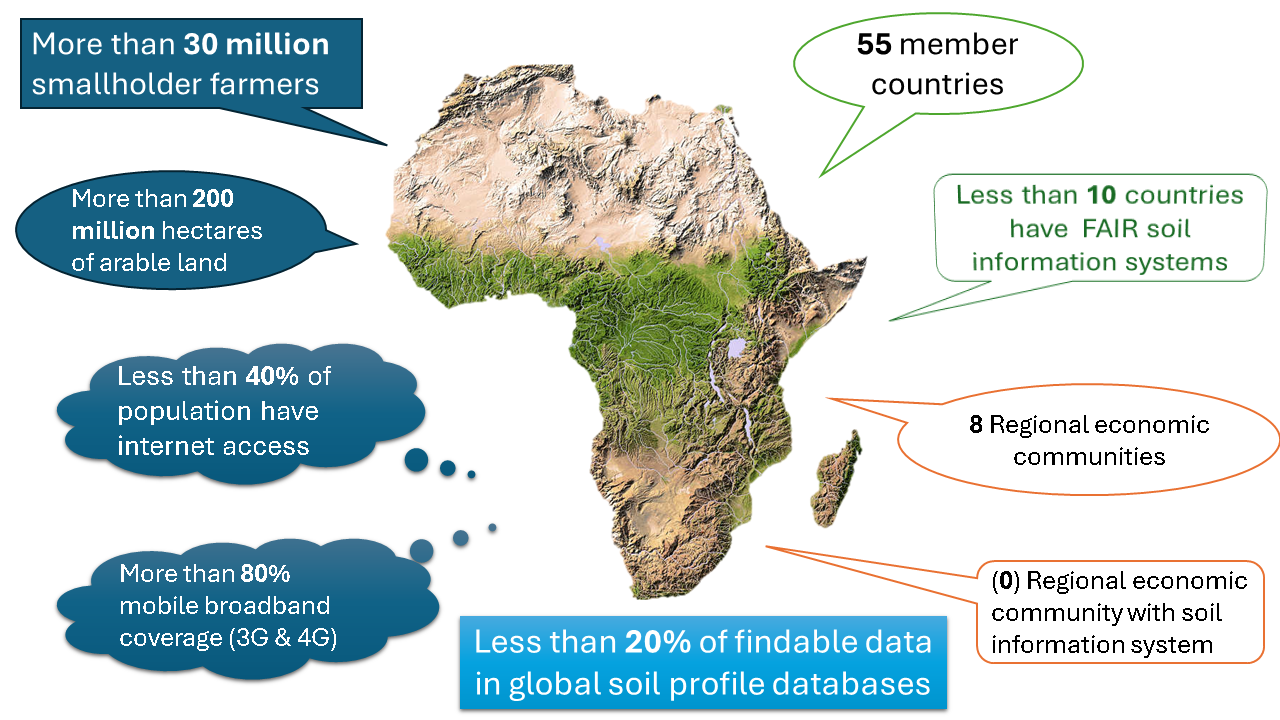1 Introduction
1.1 Background
A Soil information system (SIS) is a convenient online or digital infrastructure for managing and sharing soil data and information. Africa and most countries in Africa do not have accessible soil information systems. Soil data in Africa is mostly produced and held by various organizations and institutions inside and outside the continent at varied specifications. The existing soil data and planned data collection programs in the continent have diverse temporal and spatial characteristics as well as varied soil information content. Coherent soil information systems at different administrative levels are needed to bring the diverse soil information into organized platforms and deliver harmonized information to all users. Organized soil information is a valuable resource for supporting sustainable soil management and guiding investment decisions in agriculture and the environment. Without adequate and organized soil information, agricultural investment decisions often end up with uncertain outcomes (Bennett et al. 2021; Martin and Lawson 2022; Wang et al. 2019). This is particularly true among smallholder farmers who are the majority in most agrarian economies and whose decisions impact the overall economic growth and agricultural productivity. In Africa, which is largely agrarian, there are more than 30 million smallholder farmers who manage over 70% of the agri-food systems and implement most of the regional decisions and agreements on agriculture. The decisions the smallholder farmers make without adequate soil information have implications on the agriculture performance in Africa. A properly designed soil information system which the smallholder farmers and other users of soil information can access, benefit from, and identify with, is sure to make significant changes in the overall performance of the agriculture sector on the continent.
The Soil Initiative for Africa (SIA), which was formed in 2020 to champion soil improvement activities in Africa, is prioritizing soil health and fertilizer use as the primary focus for revitalizing agricultural productivity in the continent (FARA 2022). SIA has put development of soil information systems as one of its pillar actions towards improving soil health and sustainable use of fertilizers. It expects SIS to improve access and catalyze use of soil information in making appropriate decisions that can positively impact soil health and agricultural production. Indeed, SIS is touted worldwide as the battlefield in which the fight to improve soil health, smart agriculture, and increased smallholder productivity will be won (Bhattacharya et al. 2016; Desmet and Jonghe 1993; Hallett et al. 2017; Verdoodt and Ranst 2006). In this regard, there are a lot of activities and progress with SIS development in different parts of the world (Board on Agriculture and Natural Resources et al. 2021). In Africa, however, development of SIS is a surmountable challenge owing to the many administrative levels, scanty soil data and data collection programs, and challenges with internet service provision, among others. This calls for more consultation, awareness campaigns, partnerships, and innovative approaches to develop customizable framework that can guide and rally countries towards national soil information systems (NSIS), regional soil information systems (RSIS) and continental Africa Soil Information System (AfricaSIS). The present document outlines steps towards such a framework.
1.2 Progress with SIS development in Africa
The coverage for soil information systems in Africa is low. Out of the 55 countries in the continent, there are presently less than ten countries with national SISs (NSIS) that are findable or accessible online Figure 1.1. This represents less than 20% of NSIS coverage in the continent. At the regional level, there is no known regional soil information system in Africa. Africa has eight regional economic (RECs) blocks without any single regional soil information system. Similarly, there is no clear SIS at the continental level. Even though there were attempts to develop an Africa Soil Information Service (AfSIS) at the continental level, there is presently no single clear online access point for AfSIS. However, there are organizations, institutions, enterprises, and publications which used AfSIS soil data to develop accessible continental soil information (see for example, https://www.isda-africa.com/isdasoil/ - accessed on 20 April 2024). In general, SIS coverage in Africa is low and does not satisfy the principle of findable, accessible, interoperable, and reusable (FAIR) information (Wilkinson et al. 2016). Perhaps this low coverage and lack of FAIR SISs are partly to blame for the current state of soil health and agricultural productivity in Africa. There is a need to increase continental activities to rally the countries and regions in Africa to develop and maintain useful SIS which can improve access to soil information and its associated benefits on the continent.
The focus of this document is to provide a clear roadmap and outline necessary infrastructure needed to steer the continent into developing operational, sustainable, and interlinked soil information systems at the national, regional, and continental levels. The road map also borrows from similar frameworks which aim at strengthening NSIS (Coley et al. 2024).

Figure 1.1: Africa facts for the case to build soil information systems